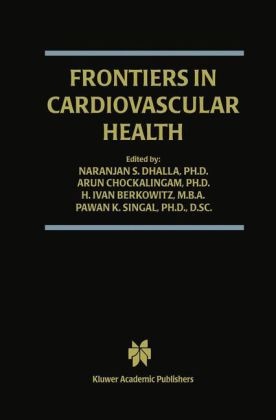Read more
Understanding the pathophysiology; cellular mechanisms of disease progression; different risk factors for cardiovascular disease; dietary effects on cardiovascular health and cultural differences are as important as dealing with the economic burden of cardiovascular mortality and morbidity. Frontiers in Cardiovascular Health discusses the factors that lead to cardiovascular death and strategies for their prevention from molecule to population.
List of contents
Dedication: A Tribute to Dr Bohuslav Ostdal. Preface. Acknowledgements.
I: Risk Factors and Cardiovascular Disease. 1. Inflammation and Cardiovascular Disease; J.T. Willerson. 2. The Role of Inflammation in Cardiac Function and Repair; M.L. Entman, et al. 3. Cardiac Repair Following Infarction; Yao Sun, K.T. Weber. 4. Protein and Phospholipids Composition of Human Myocardium in Children with Congenital Heart Disease; V. Pelouch, et al. 5. Human Atherosclerosis: New Participants? Yu.A. Romanov, et al. 6. Aging and Dietary Lipids Modulate Ca2+-Dependent Mitochondrial Function in the Post-Ischemic Heart; S. Pepe. 7. The Role of Nuclear Receptors in HDL Formation; G.A. Francis. 8. Vascular Complications in Diabetes: Risk Factors and Pathogenic Correlates; P.K. Chohan, et al. 9. Hypercholesterolemia and Cardiovascular Risk in Diabetic Patients; C. Bolego, et al. 10. Altered Substrate Utilization in the Diabetic Heart: Role of Lipoprotein Lipase; T. Chacko, et al. 11. Does Reperfusion Injury Cause Any Injury to the Myocardium? P. Ostadal, et al. 12. Fulminant Myocarditis From Lethal Disease to Survival; T. Izumi, et al. 13. Homosysteine/Coronary Atherosclerosis and Cardiac Transplantation: A Case Control Study; R.N. Kundur, et al. 14. Drug Development Based on Functional Genomics of Overloaded Cardiomyocytes: CPT1 vs. PPARalpha Effects of Etomoxir; H. Rupp, et al. 15. Mutational Profiles and Molecular Etiologies of Hypertrophic Cardiomyopathy and Dilated Cardiomyopathy in Asian Populations; A. Kimura, et al.
Summary
The Frontiers in Cardiovascular Health varies between and within nations, depend ing upon the level at which the battle is fought for better cardiovascular health. According to the 1997 World Health Report, 15 million deaths (i. e. 30% of the total number of deaths) were attributable to cardiovascular diseases and this number is on the rise. The projection for the year 2020 is quite alarming with an expected cardiovascular mortality reaching 50 million. Much of this burden is projected to occur in developing countries, more specifically in the most populous countries of the world, namely China and India. These countries are already burdened with infectious and parasitic diseases and are trying to eradicate such diseases. With increasing life expectancies people all over the world, especially in developing coun tries, are exposed to degenerative atherosclerosis resulting in increased cardiovascu lar mortality and morbidity. In developing countries, resources available for health care are very limited. For example many of the African countries spend less than $10 per person per year on his/her entire health care let alone cardiovascular health. The average health care budget for nearly two thirds of the global population is well below $100 per year, on a per capita basis. Therefore, in developing countries health promotion and primary prevention are the frontiers by necessity. Improving awareness and health education is not only a matter of choice but is an absolute necessity.

